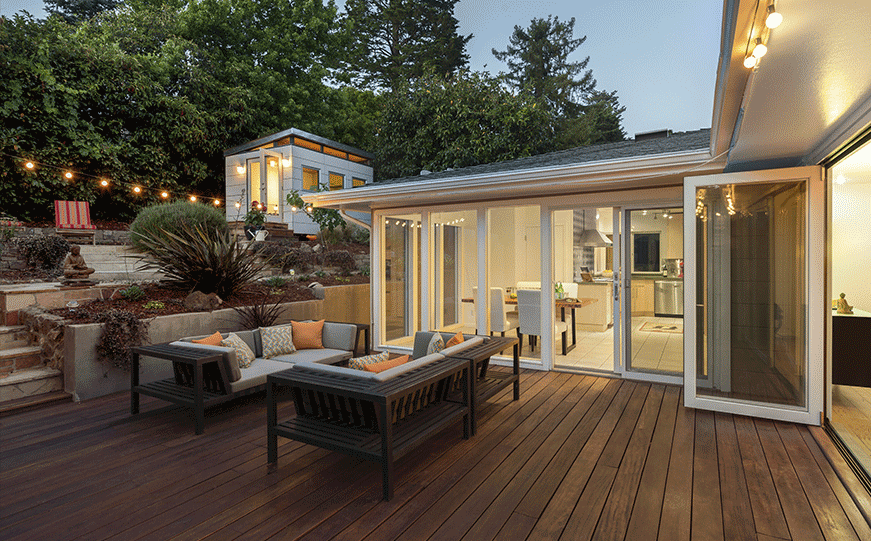Before COVID-19, homeowners were already spending more time outdoors. According to the American Institute of Architects’ Q2 2020 Home Design Trends Survey, interest in outdoor living areas continues to increase as does a desire for spaces that seamlessly transition from the indoors to outdoors.
Now, in an effort to enjoy a welcome change of scenery, time spent outdoors is on the rise. That translates to many homeowners focusing their efforts on tackling outdoor projects and reimagining their outdoor living spaces. When I recently visited Lowe’s, the garden section was packed while the rest of the store was a ghost town in comparison.
Fact is, while states have been easing restrictions on sheltering in place, many homeowners simply aren’t yet comfortable allowing contractors inside their homes. Plus, summer is right around the corner, making it a great time to spruce up an outdoor space.
And outdoor living is growing in popularity across generations, including baby boomers, who are looking for more room to host their friends and family, and millennials, who are often willing to pay more for flexible and multifunctional outdoor spaces.
All of these factors point to a wealth of opportunities for building products manufacturers and contractors who provide outdoor products and services.
So what, specifically, are homeowners looking for in their backyards and decks, and how can building product brands help them achieve their outdoor living goals?
Following are five key components for creating a beautiful and functional outdoor space… and things building product brands should keep in mind to leverage the growing outdoor trend.
Connect the indoors and outdoors. Homeowners want to be able to move effortlessly between their interior and exterior spaces. Adding sliding glass doors and lots of windows can create a connection between the indoors and outdoors while bringing in natural light and promoting a feeling of well-being. Large openings from the interior of the home to the exterior – stacked door systems, for example – encourage a natural flow while significantly expanding a home’s livable area. Incorporating decking and pavers that coordinate with interior flooring also helps to create a seamless look.
Integrate natural elements. Incorporating natural elements into outdoor living areas helps to create a harmonious and inviting space. Raised garden beds can introduce greenery and color as can hanging plants, seasonal flowers, potted trees and decorative herbs. The use of natural materials such as wood and stone not only complements the surrounding environment but helps to create a cohesive look. Water features and fire pits also bring a connection to nature. Outdoor fireplaces constructed of stone provide heat and light for cozy evenings spent relaxing on the patio or deck.
Keep it private. Ensuring privacy within an outdoor space is important, especially if neighboring homes are nearby. Building a privacy wall is an easy and cost-effective way to define an outdoor living space. A portable divider can be created using a large louvered screen or stainless steel trellis, or a more permanent structure such as a living wall featuring plants and greenery. Movable shade walls or screens can do double duty – partitioning a space while keeping outdoor spaces cool and more comfortable. Decorative features such as pergolas and gazebos also offer some privacy while bringing shade and sophistication to outdoor living areas.
Minimize maintenance: Busy homeowners don’t want to spend time painting and staining their decks or maintaining railings. Composite decking that offers the look of wood without the need to worry about insects, rot or fading is becoming increasingly popular, as are weather-resistant deck railings and infill. A number of attractive, low maintenance deck railing options are available, including cable rail infill. With its modern, streamlined aesthetic, cable rail allows for unobstructed views while creating the appearance of a larger space. It can be paired with aluminum railings, which are available in a variety of colors along with realistic wood grain finishes for an organic look without the maintenance requirements.
Light the way: Quality outdoor lighting helps outdoor living spaces transition gracefully from day into night. Lamps, lanterns and candles can be used to create an inviting ambiance, as can path and garden lighting. Using several types of lighting that complement each other can add depth while also helping to ensure safety. For example, LED lighting can be installed in a variety of ways, including strips of light, spotlights and integrated railing lighting such as under-rail and post lighting. Not only does railing lighting delineate the perimeter of a deck, but it also imparts a warm glow to the deck itself. Additionally, it increases safety by illuminating stairways, which can be challenging to navigate at night.
It’s clear that outdoor living is a trend that’s here to stay. While sheltering in place has been challenging, outdoor spaces offer a welcome breath of fresh air – and plenty of new opportunities for building product marketers.
Want to explore how your brand can optimize the growing opportunities for outdoor living? Contact us at skleber@kleberandassociates.com.





